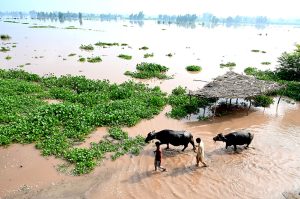ISLAMABAD: Pakistan is reeling from one of its most destructive flood seasons in recent years, with preliminary assessments revealing economic losses exceeding Rs822 billion and widespread devastation across nearly 70 districts.
According to an official report titled “A Preliminary Assessment of Flood Damages in the Economy of Pakistan (2025)”, the disaster has claimed 1,039 lives, displaced over 4 million people, and caused unprecedented destruction of homes, crops, and infrastructure nationwide.
Punjab emerged as the worst-hit province, accounting for 92% of total housing losses, with more than 213,000 homes damaged or destroyed. Sindh, Khyber Pakhtunkhwa, and Balochistan also reported severe destruction in rural belts where roads, schools, and irrigation networks were swept away.
“This disaster is a stark and painful manifestation of climate injustice,” Prime Minister Shehbaz Sharif said, noting that Pakistan contributes less than 1% of global greenhouse gas emissions yet bears a disproportionate share of climate damage.
The report estimates total sectoral damages at Rs822 billion, with agriculture alone accounting for Rs430 billion, followed by infrastructure losses worth Rs307 billion. The housing sector suffered Rs92 billion in damages, while the power sector sustained Rs25 billion in losses.
The floods also ravaged food-producing regions, destroying rice, maize, and cotton crops and threatening Pakistan’s food security. Export losses are expected to exceed $450 million, while inflation has already spiked to 5.6% — driven by rising food prices and supply chain disruptions.
Over 4 million people have been displaced, and 22,841 livestock lost, while 2,811 km of roads and 790 bridges were destroyed. The report says 243 health facilities and 2,267 schools were damaged, hampering access to essential services in flood-hit regions.
Authorities have conducted 5,769 rescue operations, evacuating 3 million people to 949 relief camps. However, thousands still remain stranded in makeshift shelters facing shortages of food, clean water, and medicines.
“Punjab has suffered the most severe housing and infrastructure damage; rebuilding will take years and require sustained financial support,” the report notes, urging immediate allocation of funds for reconstruction.
Economists warn that the floods could shave off 0.3 to 0.7 percentage points from Pakistan’s GDP growth in FY2026, reducing the expected rate to 3.5–3.9%, against the earlier target of 4.2%. The Planning Ministry cautioned that rising reconstruction costs and import requirements for food and materials may further widen the trade deficit.
Meteorological data show that monsoon rainfall in 2025 was 50% above normal, a trend experts link to global climate change. The government has called for urgent international cooperation to finance climate-resilient infrastructure, strengthen early warning systems, and invest in sustainable flood management
























